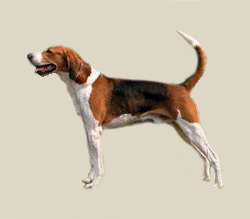
Country of Origin: United States
Group: Scenthounds and Related Breeds
Section: Scenthounds
Original Function: trailing fox
Todays Function: trailing fox
Dimension Male: 56-63,5 cm
Dimension Female: 53-61 cm
Weight Male: 18-29 kg
Weight Female: 18-29 kg
Litter Size: 5-7 puppies
Life span: 10-13 years
Other Names: none
Colors: Any colour is acceptable in this breed, but most are pie-balled with a splotch of black on the back
Living: Foxhounds require regular access to the outdoors. they don"t do well at all when they"re kept indoor
Recognized: FCI, AKC, CKC, NKC, NZKC, CKC, APRI, ACR
Description
While similar to its English cousin, the American Foxhound has been developed by its breeders to be lighter and taller, to have a keener sense of smell, and to be even faster in the chase. A large, handsome hound, its front legs are long and very straight-boned. The head is long with a slightly domed, large skull. The ears are broad and pendant, framing the face. The eyes are large and wide-set - either brown or hazel, with a sweet, imploring expression. The ears are wide, flat to the head and its tail is carried cheerfully with a slight upward curve, like a sickle. The short, hard coat may be any color.
Temperament
Although by tradition the foxhound is not a house pet, it is actually well-mannered in the home. It gets along best with human or canine companionship. It is a tolerant, amiable and gentle dog, even though it is not very demonstrative. Most are reserved with strangers. It is first and foremost a hunter, ever ready to hit the trail. It needs daily exercise in a safe area. Once on a scent, it will follow gleefully, heedless of commands. This is a dog that likes the outdoors; it is not a city dog. It bays.
Excercise
The foxhound needs daily exercise, preferably in the form of a long walk or jog. If allowed to run off leash, it should only do so in a safe, enclosed area. Foxhounds traditionally live outside, although only with warm shelter and bedding and in temperate climates. They are highly sociable, however, and should never be expected to live alone. The coat is easily maintained, requiring only occasional brushing to remove dead hair.
Grooming
The smooth, short-haired coat is easy to groom. Comb and brush with a firm bristle brush, and shampoo only when necessary. This breed is an average shedder.
Health
Major concerns: none
Minor concerns: thrombocytopathy
Occasionally seen: none
Suggested tests: blood,
Click here to ORDER this PUPPY
